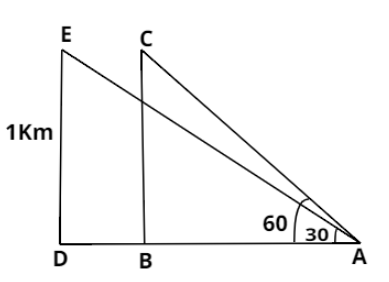
Answer
479.1k+ views
Hint: Consider different triangles of different positions of the aeroplane. The distance travelled by the aeroplane in 10 seconds will be the difference between the different positions.
Complete step-by-step answer:

In the above figure, C is the initial position of the aeroplane. Its height above the ground is 1 km. Initial angle of elevation is ${60^ \circ }$. Then in triangle ABC, we have:
$
\Rightarrow \tan {60^ \circ } = \dfrac{{BC}}{{AB}}, \\
\Rightarrow \sqrt 3 = \dfrac{1}{{AB}}, \\
\Rightarrow AB = \dfrac{1}{{\sqrt 3 }} .....(i) \\
$
From the figure, $CE = BD$
Let the uniform speed of the aeroplane is $v{\text{ km/hr}}$. It moves horizontally for 10 seconds and reaches point E. We know, Distance $ = $Speed $ \times $time. Applying this, we’ll get:
$ \Rightarrow CE = v \times \dfrac{{10}}{{60 \times 60}}$
From the figure, $CE = BD$. So, we have:
$ \Rightarrow BD = v \times \dfrac{{10}}{{60 \times 60}} .....(ii)$
From the figure, we have:
$ \Rightarrow AD = AB + BD$
Putting the values of AB and BD from equations $(i)$ and $(ii)$ respectively, we’ll get:
$ \Rightarrow AD = \dfrac{1}{{\sqrt 3 }} + v \times \dfrac{{10}}{{60 \times 60}} .....(iii)$
The angle of elevation of the aeroplane now is ${30^ \circ }$. Thus, in triangle ADE, we have:
$
\Rightarrow \tan {30^ \circ } = \dfrac{{DE}}{{AD}}, \\
\Rightarrow \dfrac{1}{{\sqrt 3 }} = \dfrac{1}{{AD}}, \\
\Rightarrow AD = \sqrt 3 \\
$
Now putting the value of AD from equation $(iii)$, we’ll get:
$
\Rightarrow \dfrac{1}{{\sqrt 3 }} + v \times \dfrac{{10}}{{60 \times 60}} = \sqrt 3 , \\
\Rightarrow \dfrac{v}{{6 \times 60}} = \sqrt 3 - \dfrac{1}{{\sqrt 3 }}, \\
\Rightarrow \dfrac{v}{{60 \times 2 \times 3}} = \dfrac{2}{{\sqrt 3 }}, \\
\Rightarrow v = 60 \times 2 \times \sqrt 3 \times 2, \\
\Rightarrow v = 240\sqrt 3 \\
$
Thus the speed of the aeroplane is $240\sqrt 3 $ km/hr.
Note: The question can be solved in this way only if the aeroplane is moving horizontally. If it is moving at any other angle, the triangles formed will be different than this.
Complete step-by-step answer:

In the above figure, C is the initial position of the aeroplane. Its height above the ground is 1 km. Initial angle of elevation is ${60^ \circ }$. Then in triangle ABC, we have:
$
\Rightarrow \tan {60^ \circ } = \dfrac{{BC}}{{AB}}, \\
\Rightarrow \sqrt 3 = \dfrac{1}{{AB}}, \\
\Rightarrow AB = \dfrac{1}{{\sqrt 3 }} .....(i) \\
$
From the figure, $CE = BD$
Let the uniform speed of the aeroplane is $v{\text{ km/hr}}$. It moves horizontally for 10 seconds and reaches point E. We know, Distance $ = $Speed $ \times $time. Applying this, we’ll get:
$ \Rightarrow CE = v \times \dfrac{{10}}{{60 \times 60}}$
From the figure, $CE = BD$. So, we have:
$ \Rightarrow BD = v \times \dfrac{{10}}{{60 \times 60}} .....(ii)$
From the figure, we have:
$ \Rightarrow AD = AB + BD$
Putting the values of AB and BD from equations $(i)$ and $(ii)$ respectively, we’ll get:
$ \Rightarrow AD = \dfrac{1}{{\sqrt 3 }} + v \times \dfrac{{10}}{{60 \times 60}} .....(iii)$
The angle of elevation of the aeroplane now is ${30^ \circ }$. Thus, in triangle ADE, we have:
$
\Rightarrow \tan {30^ \circ } = \dfrac{{DE}}{{AD}}, \\
\Rightarrow \dfrac{1}{{\sqrt 3 }} = \dfrac{1}{{AD}}, \\
\Rightarrow AD = \sqrt 3 \\
$
Now putting the value of AD from equation $(iii)$, we’ll get:
$
\Rightarrow \dfrac{1}{{\sqrt 3 }} + v \times \dfrac{{10}}{{60 \times 60}} = \sqrt 3 , \\
\Rightarrow \dfrac{v}{{6 \times 60}} = \sqrt 3 - \dfrac{1}{{\sqrt 3 }}, \\
\Rightarrow \dfrac{v}{{60 \times 2 \times 3}} = \dfrac{2}{{\sqrt 3 }}, \\
\Rightarrow v = 60 \times 2 \times \sqrt 3 \times 2, \\
\Rightarrow v = 240\sqrt 3 \\
$
Thus the speed of the aeroplane is $240\sqrt 3 $ km/hr.
Note: The question can be solved in this way only if the aeroplane is moving horizontally. If it is moving at any other angle, the triangles formed will be different than this.
Recently Updated Pages
How many sigma and pi bonds are present in HCequiv class 11 chemistry CBSE

Mark and label the given geoinformation on the outline class 11 social science CBSE

When people say No pun intended what does that mea class 8 english CBSE

Name the states which share their boundary with Indias class 9 social science CBSE

Give an account of the Northern Plains of India class 9 social science CBSE

Change the following sentences into negative and interrogative class 10 english CBSE

Trending doubts
Fill the blanks with the suitable prepositions 1 The class 9 english CBSE

Which are the Top 10 Largest Countries of the World?

Give 10 examples for herbs , shrubs , climbers , creepers

Difference Between Plant Cell and Animal Cell

Difference between Prokaryotic cell and Eukaryotic class 11 biology CBSE

The Equation xxx + 2 is Satisfied when x is Equal to Class 10 Maths

Change the following sentences into negative and interrogative class 10 english CBSE

How do you graph the function fx 4x class 9 maths CBSE

Write a letter to the principal requesting him to grant class 10 english CBSE



